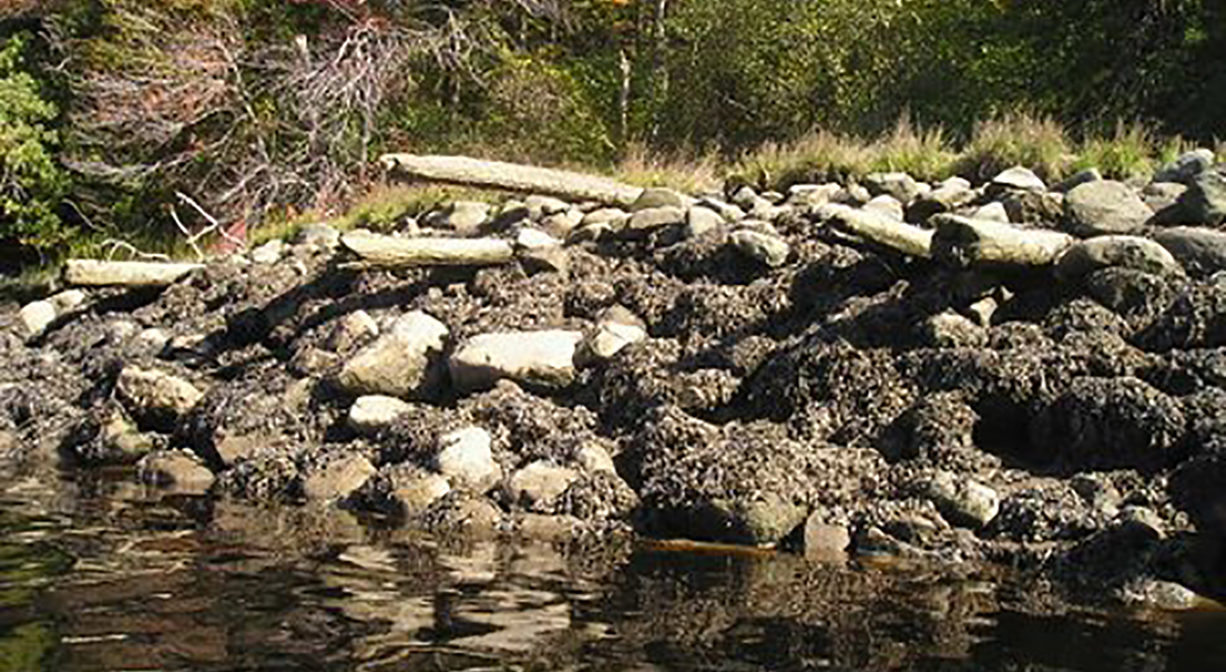New England Forestry Foundation: 978-952-6856
https://newenglandforestry.org/explore-our-forests/forest-stories/#nelson-memorial-forest
Owned By: New England Forestry Foundation
This packet Landing, located directly on the North River at Nelson Memorial Forest in Marshfield, is what remains of an early wharf built of logs and stone. For 200 years beginning in the 1600’s, packet ships sailed up and down the North River, buying and selling goods.
Please do not disturb this historical artifact. It is visible at most tides, and can be viewed both from the land and from the water.
Features
The Packet Landing is a historic spot that evokes the North River’s rich commercial history. In the book Pembroke: Ancient Trails to the 21st Century, Joseph Chetwynd describes packet landing construction as follows. “The landings were most likely built of crib-logs, back-filled with rocks and topped with gravel, with dead-man posts set up as bollards for tying up the vessels. These landings ran parallel to the shoreline and projected into the stream as little as was necessary so as not to impede the flow of traffic in the stream. They may also have incorporated vertical sheathing on the facing to act as fenders for the boats as they lay against the bulkhead.”
Packet ship lines were established prior to 1670, and thrived until railroads came to the South Shore in the mid-to-late 1800s. Over time, White’s Ferry, Little’s Bridge, Union Bridge, Hobart’s Landing, Foster’s Landing (aka Curtis-Wanton Yards), Job’s Landing, Brick-Kiln Yard, and the North River Bridge (Washington Street Bridge) in Hanover became regular stops. Farmers would meet the packet ship and barter their home-grown vegetables and dairy products for goods from China and Mediterranean, such as coffee, sugar and spices. In addition to home-grown goods, packet pilots also bought wood, fish, pot iron, and charcoal from locals, and sold them lumber and ship supplies. A typical packet run, up and down the river, could take three or four days.
This land is within the region of the Massachusett (or Massachuseuk). To learn more about local Native American tribes, we encourage you to interact with their members. The Massachusett tribe at Ponkapoag and the Mattakeeset band of the Massachusett share information on their websites.
Trail Description
There are about 3 miles of interconnecting trails in Nelson Memorial Forest. Many of them are wide cart paths and unpaved logging roads, but there are also some narrower footpaths. Some trails are well-marked. Others could use some tidying up. The New England Forestry Foundation occasionally harvests trees here.
The property extends for a considerable distance along the side of a hill. Depending on where you enter and exit, your hike could involve a long uphill climb. Although the trails within the forest are often wide, the access trails from the parking areas are not, so maneuvering a stroller into Nelson Forest is not an easy feat!
The best access to the Packet Landing is through Union Street Woodland. Portions of this trail are narrow, but keep going and you’ll find flatter, wider paths ahead. Entering from the Union Street Woodland spur trail, you will come to a T intersection. This is the River Pasture Road. Head downhill, and after passing at least 2 old stone walls, look for a narrower trail to the left. This leads down a steep incline to an overlook on the banks of the North River. If you walk out to the river’s edge and look downstream, you should be able to see what remains of the Packet Landing.
Habitats and Wildlife
Nelson Memorial Forest is full of wildlife, ranging from white-tailed deer to the tiny 4-toed salamander that can be found near the small creeks. Look for grey squirrels collecting acorns, and raccoons foraging by the river’s edge. Perhaps you’ll see a long-billed marsh wren in the marsh areas, or osprey along Cove Creek. Much of the forest is pine and oak, with some holly here and there. Near the Highland Street trailhead, there is a grove of maple trees that are often tapped for syrup in the springtime. Farther into the property is a lovely grove of beech trees. Near the Union Street Woodland entrance is a small grove of hemlock.
This property is located on the North River one of its many tributaries, Cove Creek. Approximately 10 miles in length, the North River begins at the confluence of the Indian Head River (Hanover) and Herring Brook (Pembroke). From there it flows through the towns of Hanover, Pembroke, Marshfield, Norwell, and Scituate. It empties into the Atlantic Ocean between Third and Fourth Cliffs, draining approximately 59,000 acres along the way.
Historic Site: Yes
Park: No
Beach: No
Boat Launch: No
Lifeguards: No
Size: A tiny landmark within 180 acres.
Hours: Dawn to Dusk
Parking: Park at Union Street Woodland. Look for the small parking area on Union Street, near Hunter Drive.
Cost: Free
Trail Difficulty: Easy, Medium
Facilities:
Bench.
Dogs: Dogs must remain on leash. Please clean up after your pet!
Boat Ramp: No
ADA Access: No
Scenic Views: Yes
Waterbody/Watershed: North River





